Windows 11/10, offers Narrator feature. The feature helps those needing aid with vision, hearing, or dexterity impairments. It can help elders or those with dexterity and mobility impairments by birth. In this guide, I will share how you can use the Narrator in Windows 11/10.
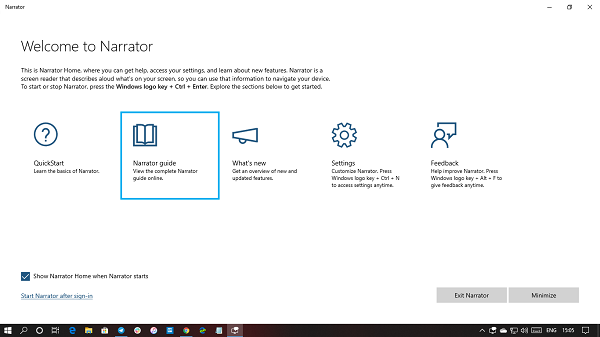
How to use the Narrator in Windows 11/10
The Narrator is a built-in tool that can be used to read text aloud. It is a built-in accessibility feature. It can read out text on the computer, documents, settings, events that happen on the computer, i.e., when you turn off the volume or click on button more information about it is spoken out. It is useful for those who have a problem with their vision and can help them to use the computer.
- How to start Narrator in Windows
- How to automatically start Narrator when Windows starts
- How to turn off Narrator in Windows
- What is the Narrator key
- Narrator Settings
- Start-up Options
- Personalize Narrators Voice
- Choose what Narrator can read
- Choose what you hear while typing
- Create your commands using Keyboard Settings
- Windows Narrator keyboard shortcuts
1] How to start Narrator in Windows 11/10
If you need Narrator often, it is best to set it to launch right when Windows Start. It will make sure there is no need to launch it every time you log in to the computer. However, if its the first time, use Win+Ctrl+Enter to launch the narrator instantly, and choose to Start Narrator after sign-in.
2] How to automatically start Narrator when Windows starts
- Open Windows Settings
- Click Accessibility settings
- Select Narrator
- Check the Start Narrator after sign-in box.
3] How to turn off Narrator in Windows 11/10
To exit the Narrator, press Caps Lock+Esc. If you only want to pause the reading, you can press Ctrl and resume back reading with Caps Lock+M.
Read: How to disable Narrator using Registry.
4] What is the Narrator Key?
In Windows 11/10, Caps Lock key or INSERT key is the Narrator key.
Read: How to configure Narrator settings in Windows
5] Narrator Settings
That said, since you will be using the Narrator, it is best to set it up, so it meets your requirements. The first thing you should do is to make sure the Narrator starts minimized. The option is available right up front in the Narrator windows—uncheck the box which says, “Show Narrator home when the narrator starts.”
Then click on Settings icon or use Windows Key + Control + N to open it directly. Then follow these to setup:
a] Start-up Options
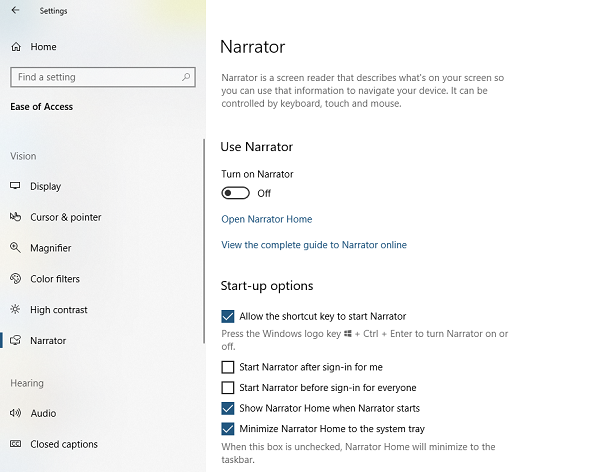
- Enable disable the Narrator shortcut
- Start of Narrator after sign-in for logged-in user or all of them
- Show or Hide the Narrator home
- Minimize the Narrator to the system tray
b] Personalize Narrators Voice
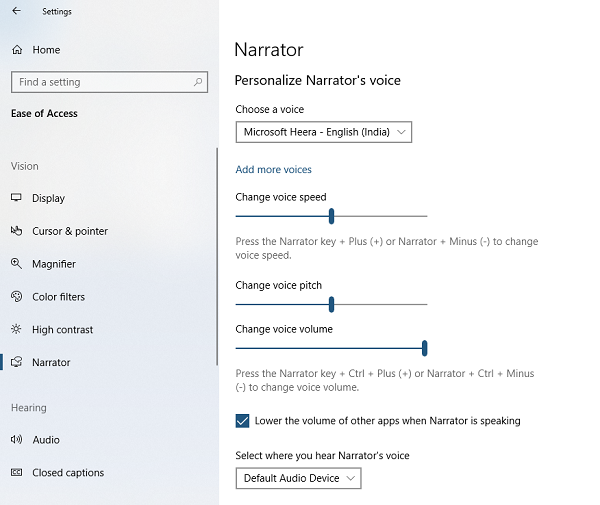
The settings here allow you to configure the Narrator to be effective. You can change the default voice, speed, voice pitch, and volume. You can choose to lower the volume of other apps.
If you have multiple audio devices, you can choose the output of the device. To control the volume of the Narrator use Caps Lock+Page Up to increase or Caps Lock+Page Down to decrease voice volume.
Read: How to Add or Remove Natural Voices in Narrator on Windows 11
c] Choose what Narrator can read
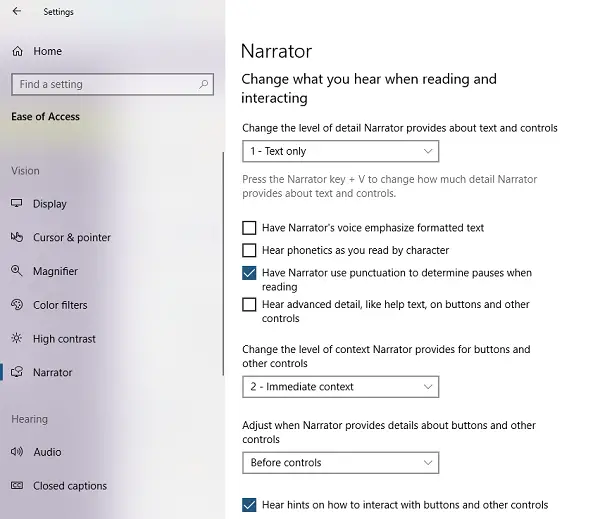
Narrator by default, reads everything you click, press on the keyboard, or move using the keyboard. While it is good to have all options turned on, as you get used to it, make sure to turn off what you do not need.
There are five levels from which you can choose.
- Text only
- Some control details
- All control details
- Some text details
- All text details
You can switch between them using Narrator key + V to switch between them. Then you can make choices for emphasis for formatted text, phonetics, punctuation pause, hear advanced details, and so on.
Similarly, you can change the level of contextual provider buttons, gear hints on how to interact with certain things on Windows and audio cues.
d] Choose what you hear while typing
The narrator keeps prompting as you type. It can be annoying. If you are good with the keyboard, you can remove some of the features.
I would suggest turning off the option to speak out every word and keep it to the only function keys, such as Function keys, Shift, Alt, and so on.
e] Create your commands using Keyboard Settings
Using these settings, you can change the keyboard layout, lock the narrator key, and lastly create your commands. The last two options are very useful if you find multiple key combinations challenging to remember. Click on Create your commands link, and then change accordingly.
Lastly, you can use Braille with Narrator. You need to install the software that lets the computer communicate with it.
6] Windows Narrator keyboard shortcuts
- Ctrl: Stop reading.
- Caps Lock+M: Start reading.
- Caps Lock+Page Up: Increase voice volume.
- Caps Lock+Page Down: Decrease voice volume.
- Caps Lock+Plus: Increase voice speed.
- Caps Lock+Minus: Decrease voice speed.
- Caps Lock+C: Read the current date and time.
- Caps Lock+D: Read item.
- Caps Lock+S: Read item spelled out.
- Caps Lock+V: Repeat phrase.
- Caps Lock+W: Read window.
- Caps Lock+H: Read the document.
- Caps Lock+Ctrl+U: Read the current page.
- Caps Lock+U: Read next page.
- Caps Lock+Shift+U: Read the previous page.
- Caps Lock+Ctrl+I: Read current paragraph.
- Caps Lock+I: Read the next paragraph.
- Caps Lock+Shift+I: Read the previous paragraph.
- Caps Lock+Ctrl+O: Read a current line.
- Caps Lock+O: Read next line.
- Caps Lock+Shift+O: Read the previous line.
- Caps Lock+Ctrl+P: Read the current word.
- Caps Lock+P: Read the next word.
- Caps Lock+Shift+P: Read the previous word.
- Caps Lock+R: Read all items in containing the area.
- Caps Lock+Q: Move to the last item in containing the area.
- Caps Lock+Y: Move to the beginning of the text.
- Caps Lock+B: Move to end of the text.
- Caps Lock+J: Jump to next heading.
- Caps Lock+Shift+J: Jump to the previous heading.
- Caps Lock+K: Jump to next table.
- Caps Lock+Shift+K: Jump to the previous table.
- Caps Lock+L: Jump to next link.
- Caps Lock+Shift+L: Jump to the previous link.
- Caps Lock+F3: Jump to next cell in the row.
- Caps Lock+Shift+F3: Jump to the previous cell in the row.
- Caps Lock+F4: Jump to next cell in the column.
- Caps Lock+Shift+F4: Jump to the previous cell in the column.
- Caps Lock+Space: Do primary action.
- Caps Lock+Right Arrow: Move to next item.
- Caps Lock+Left Arrow: Move to the previous item.
- Caps Lock+Up/Down Arrow: Change view.
- Caps Lock+F1: Show commands list.
- Caps Lock+F2: Show commands for the current item.
- Caps Lock+F12: Toggle character reading.
- Caps Lock+Enter: Toggle search mode.
- Caps Lock+Num Lock: Toggle mouse mode.
- Caps Lock+A: Change verbosity mode.
- Caps Lock+Esc: Exit Narrator.
- Caps Lock+Z: Lock Narrator key.
- Caps Lock+G: Move Narrator cursor to system cursor.
- Caps Lock+T: Move the Narrator cursor to the pointer.
- Caps Lock+Backspace: Go back 1 item.
- Caps Lock+Insert: Jump to linked item.
- Caps Lock+F7: Read the current column.
- Caps Lock+F8: Read the current row.
- Caps Lock+F9: Read current column header.
- Caps Lock+F10: Read current row header.
- Caps Lock+F5: Read which row and column Narrator is in.
- Caps Lock+F6: Jump to the table cell.
- Caps Lock+Shift+F6: Jump to cell contents.
- Caps Lock+Ctrl+Left Arrow: Navigate to parent.
- Caps Lock+Ctrl+Down Arrow: Navigate to the next sibling.
- Caps Lock+Ctrl+Up Arrow: Navigate to the previous sibling.
The full list of Narrator & Magnifier keyboard shortcuts is listed here.
We are sure that Windows 11/10 users will find this Accessibility feature very useful.
Windows Narrator features
While I am sure the list covers most of the new features, I am sure there are many small changes that only those who use the Narrator daily. Here is the list:
- Narrator Startup Options
- Change how much content you hear
- Change what you hear when typing
- Read and navigate between sentences
- Additional Improvements
I could say one thing about the Narrator changes: Microsoft has made it such that it will bother you less and you can filter out a lot of things that cause distraction.
1] Narrator Startup Options
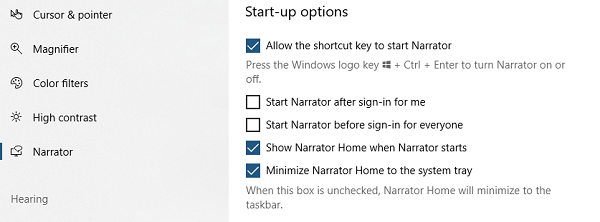
Starting with Windows 10 v1903, you will notice these two options:
- Show Narrator Home when the Narrator starts
- Minimize Narrator Home to the System tray
If you are used to Narrator, uncheck the Minimize Narrator Home option. It will minimize it to the System Tray.
2] Change what you hear when reading and interacting
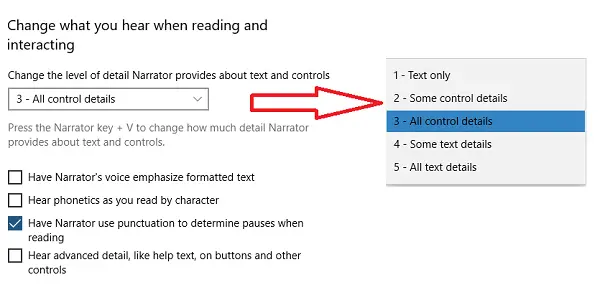
The section allows you to control how much of the text you year. There are five new verbosity levels:
- Text only
- Some control details
- All control details
- Some text details
- All text details
It is possible to cycle through all the levels using the Narrator + V command. Under this section, you have a couple of options which are either new or rearranged. It includes options for
- Voice emphasize formatted text
- Have the Narrator use punctuation to determine pauses when reading.
- Hear advanced detail, like help text, on buttons and other controls option
3] Change what you hear when typing
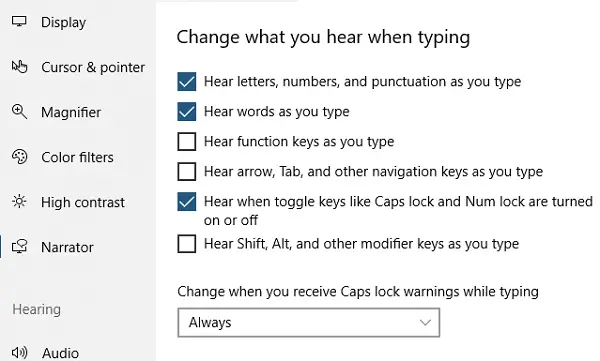
The Narrator also works when you are typing. However, choose carefully else it will be an overburden. The settings offer discrete options for the following. You will hear:
- Letters, numbers, and punctuation as you type
- Words as you type
- Function keys as you type.
- Arrow, Tab, and other navigation keys as you type.
- When you toggle keys like Caps lock and Num lock are turned on or off.
- Shift, Alt, and other modifier keys as you type.
There is a specific option for Caps lock. It can warn you every time you turn it on. It’s useful if you accidentally turn it on.
4] Read and navigate between sentences
V1903 makes sure that you can hear each sentence easily, and if you miss, you can navigate between them using keyboard shortcuts.
- Caps + Ctrl + . = Next sentence
- Caps + Ctrl + , = Current sentence
- Caps + Ctrl + M = Previous sentence
4] Additional Improvements
- The narrator stays on if you forget your PIN or Password, and help you reset.
- The narrator can detect and speak the combo edit.
- The phonetics are no longer announced. You will have to Narrator key + Comma twice quickly command to hear the phonetics.
- Supports BRLTTY version 5.6
Let us know if you find any missing feature in our post. We would love to add it here.
Leave a Reply